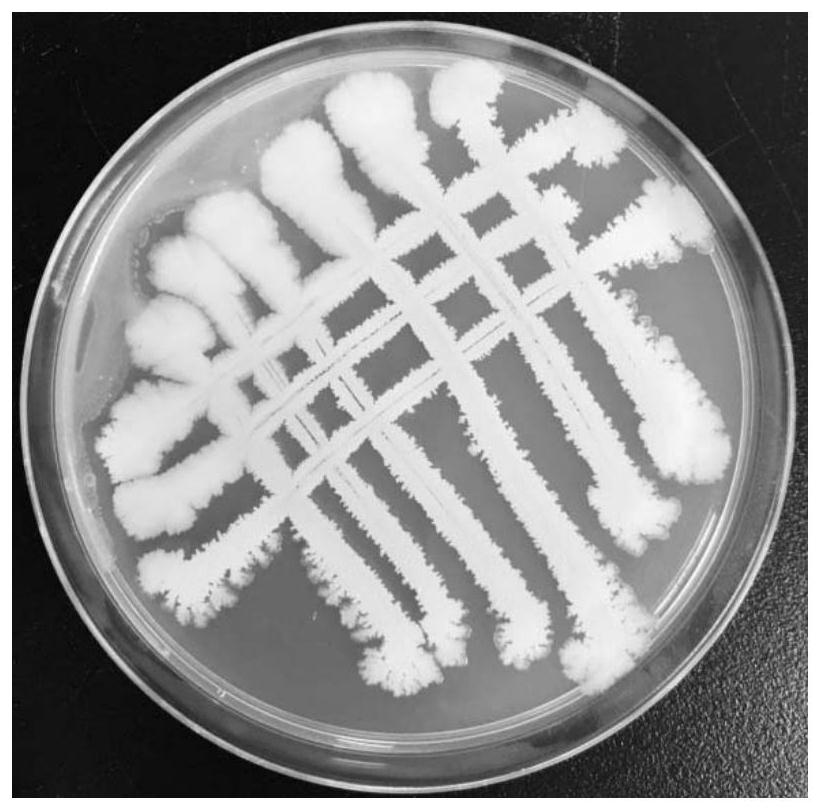Halobacillus sp. strain and use thereof
A technology of bacillus and bacterial liquid, which is applied in the field of plant disease control and microorganisms, can solve the problems of long treatment cycle, easy to cause pollution, cure the symptoms but not the root cause, and achieve the effects of reducing the incidence rate, increasing the yield, and broad application prospects
- Summary
- Abstract
- Description
- Claims
- Application Information
AI Technical Summary
Problems solved by technology
Method used
Image
Examples
Embodiment 1
[0059] Example 1: Isolation and purification method of Bacillus halo Y10312
[0060] The separation and purification method of the halobacterium bacillus Y10312 bacterial strain of the present invention, the steps are as follows:
[0061] S1: Weigh 10g of soil sample, said soil sample comes from the mangrove soil of Hailing Island Mangrove National Wetland Park in Guangdong Province; then, add 90ml of sterile water to the soil sample in the ultra-clean workbench, place the shaker Shake on the mixer for 60 minutes, so that the soil sample is evenly dispersed in the diluent to form a soil suspension; after the soil is dispersed, draw 100ul of the soil suspension into 900ul of sterile water to obtain a 10-fold dilution, and then dilute 10 times in turn to obtain a 10-fold dilution. 2 Double dilution, 10 3 Double dilution, 10 4 Double dilution, 10 5 double dilution and 10 6 Double dilution, the whole process is carried out in the ultra-clean workbench.
[0062] S2: Take 100ul...
Embodiment 2
[0067] Embodiment two: the antagonism of bacillus halo Y10312 to Pythium ingross and Fusarium solani
[0068] S1 Inoculation: Take the glycerin seed solution stored at -20°C in Example 1 and inoculate it into 2216E liquid medium with an inoculum volume ratio of 1:100 between the bacterial solution and the medium, and place it in a constant temperature shaker for constant temperature shaking at 28°C. 28h, to obtain the activated bacterial liquid;
[0069] Identification of S2 medium: use plate confrontation method. Get the pathogenic flora Pythium insolata ( image 3 ) and Fusarium solani ( Figure 4 ) bacterial block (diameter 0.8cm), placed in the center of the PDA solid medium, at a distance of 2cm from the bacterial block, absorb 20ul of activated bacterial liquid and spot in three parallel groups; at the same time, the plate of the control group is only spot in the center of the plate Pathogens: After inoculation, place in a biochemical incubator at 28°C for 3-5 days to...
Embodiment 3
[0071] Embodiment three: Bacillus halo Y10312 culture method
[0072] This example provides the cultivation methods of two strains of Bacillus halobacterium Y10312.
[0073] The first culture method uses 2216E liquid medium, the process is as follows:
[0074]Activation before cultivation: Take the glycerin seed liquid stored at -20°C in Example 1 and inoculate it into 2216E liquid medium with an inoculum volume ratio of 1:100 between the bacterial liquid and the medium, and place it in a constant temperature shaker at 28°C for constant temperature oscillation. Cultivate for 28 hours to obtain activated bacterial liquid.
[0075] S1 Inoculation: Take the activated bacterial liquid and inoculate it into 500ml 2216E liquid medium according to the volume ratio of the bacterial liquid to the medium: 1:100;
[0076] S2 culture: place the above-mentioned culture bottle inoculated with the bacillus halobacterium strain Y10312 in a constant temperature shaker, and cultivate it at a ...
PUM
 Login to View More
Login to View More Abstract
Description
Claims
Application Information
 Login to View More
Login to View More - R&D
- Intellectual Property
- Life Sciences
- Materials
- Tech Scout
- Unparalleled Data Quality
- Higher Quality Content
- 60% Fewer Hallucinations
Browse by: Latest US Patents, China's latest patents, Technical Efficacy Thesaurus, Application Domain, Technology Topic, Popular Technical Reports.
© 2025 PatSnap. All rights reserved.Legal|Privacy policy|Modern Slavery Act Transparency Statement|Sitemap|About US| Contact US: help@patsnap.com



